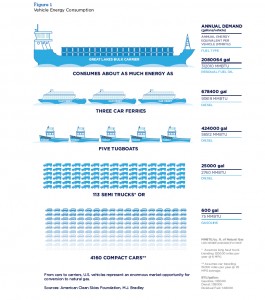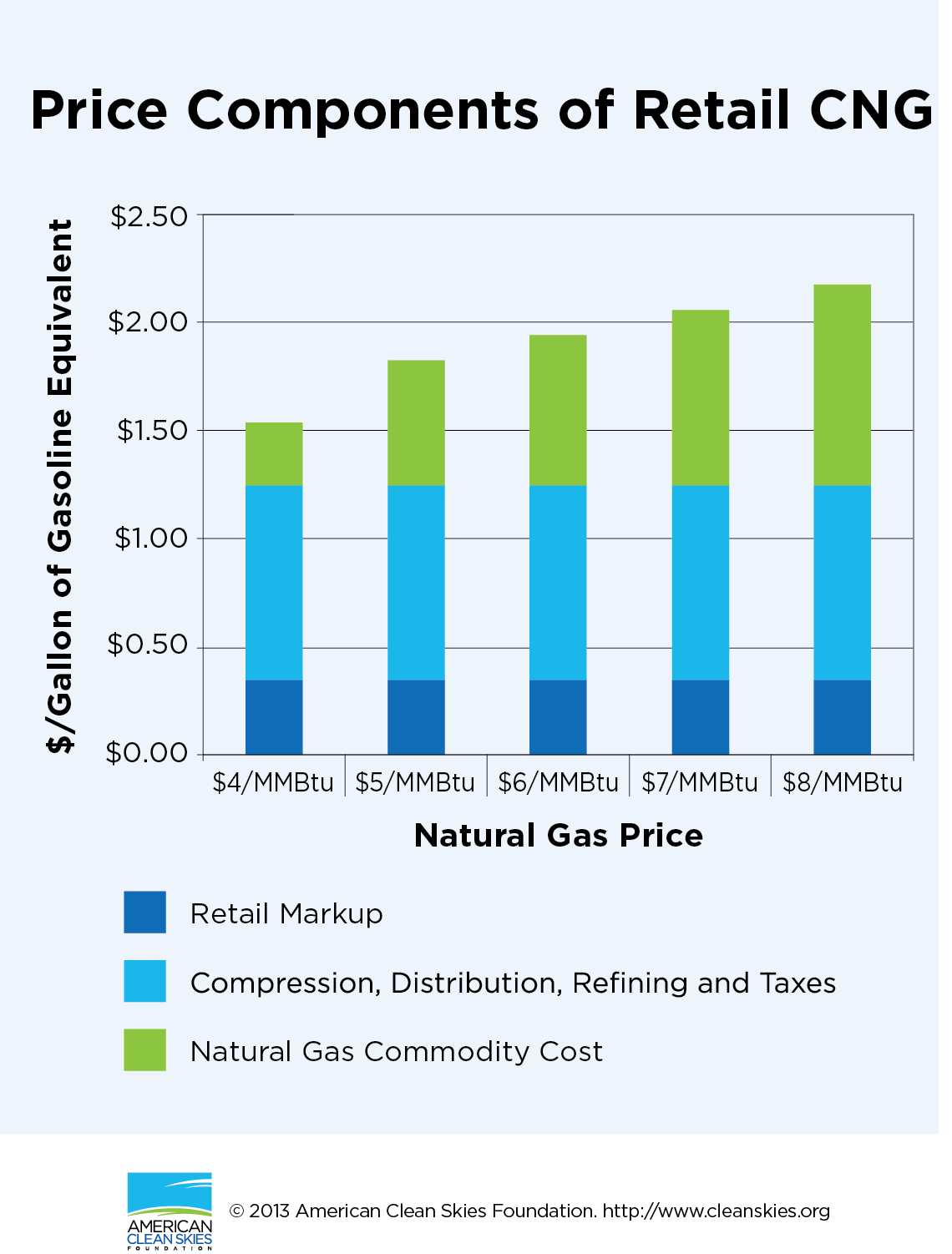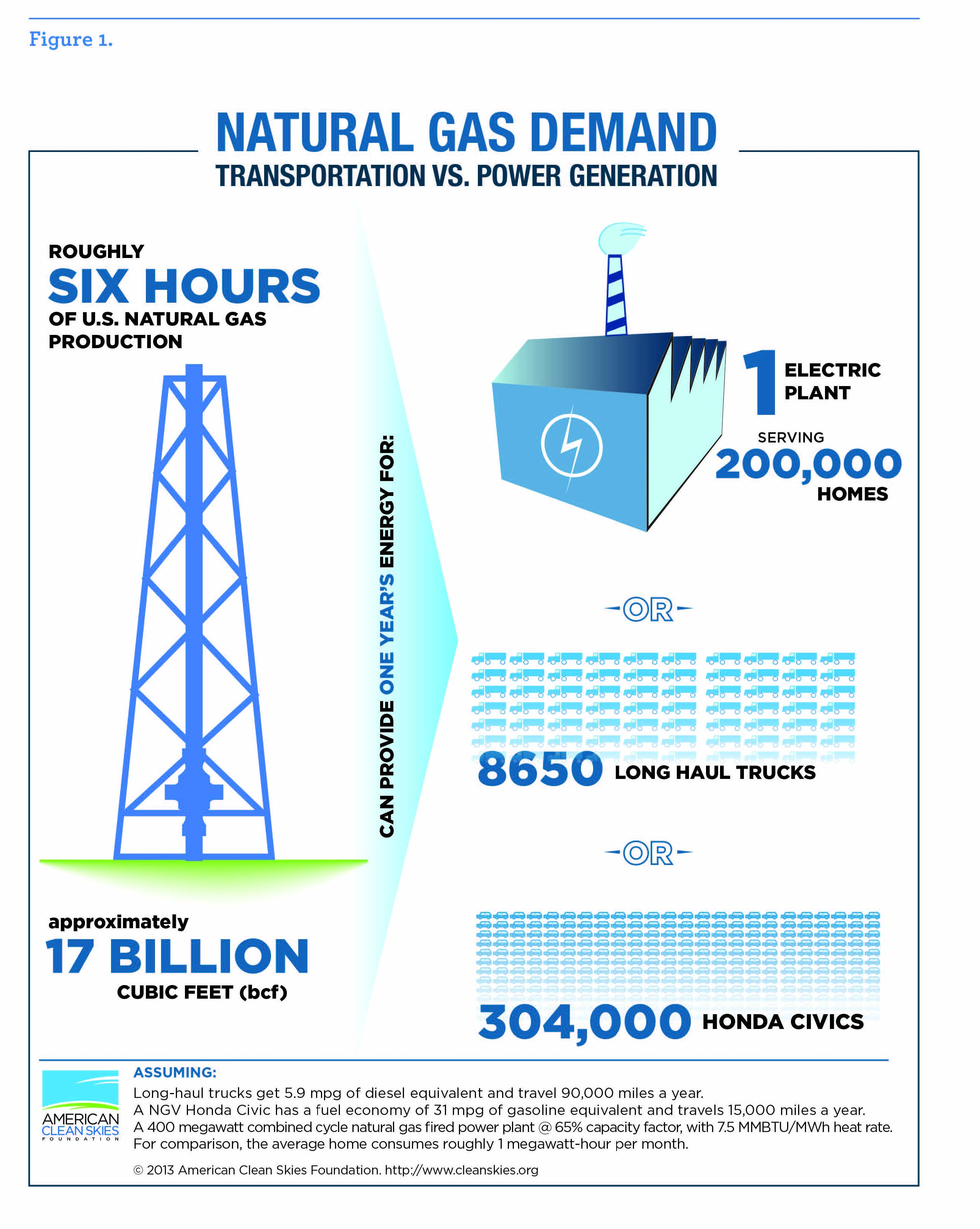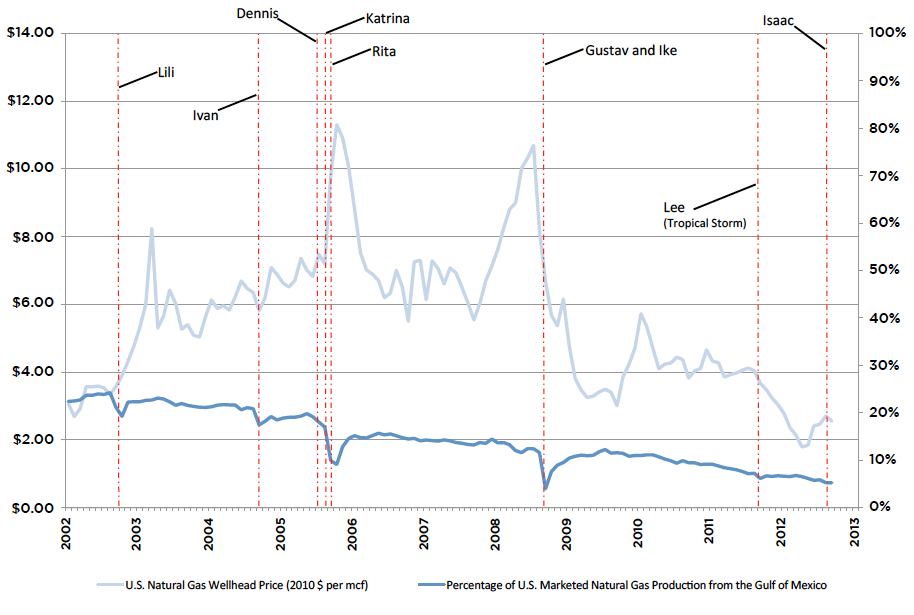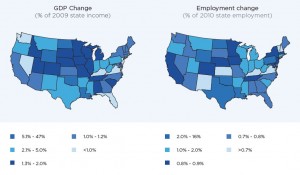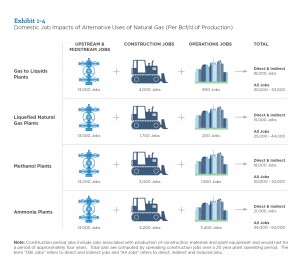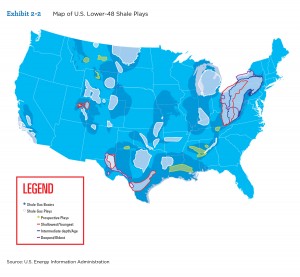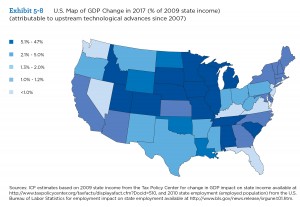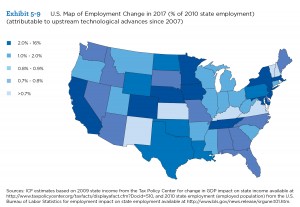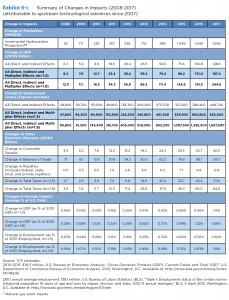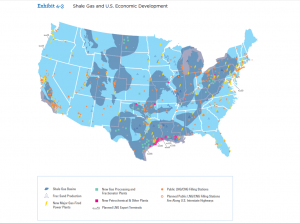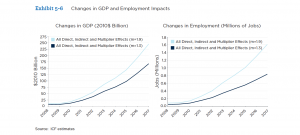March 2015 Obama Order on Sustainability Practices For Federal Agencies Builds On Green Procurement Proposals Made In ACSF’s Landmark Oil Shift Report

On March 19, President Obama issued a new Executive Order, “Planning for Federal Sustainability in the Next Decade,” which directs federal agencies to cut their greenhouse gas emissions by 40 percent by 2025. The new EO focuses on efficiency improvements, increased renewable electricity use and reductions in greenhouse gas emissions associated with energy used at federal facilities and in agency motor vehicle fleets.
Importantly, however, the EO also includes new requirements for measuring and reducing the greenhouse gas footprint of the federal supply chain. In future purchases, the seven largest procuring agencies must now plan to include, as appropriate, contract requirements for vendors or evaluation criteria that consider contractor emissions and greenhouse gas management practices.
The American Clean Skies Foundation applauds the adoption of these new supply chain management requirements. This new guidance reflects the recommendations of ACSF’s 2012 Oil Shift report, which the Foundation issued to encourage the federal government to reduce its environmental footprint. ACSF’s landmark report urged federal agencies to apply to third-party suppliers the same kinds of alternative fuel targets, efficiency standards and reporting practices they applied to their own vehicle fleets.
The Foundation has worked to urge the Department of Defense, the General Services Administration, and other federal agencies to value cleaner fuel use when awarding new multi-billion dollar contracts, and we look forward to continuing the focus on ways we can help the federal government purchase greener, more fuel efficient, lower cost shipping and delivery services.
The new Executive Order is available here: https://www.whitehouse.gov/the-press-office/2015/03/19/executive-order-planning-federal-sustainability-next-decade
Opinion: GSA Opts for Clean-Fueled Vendors
GSA proposes assessing package delivery vendors on environmental and alternative fuel benchmarks
Feds Move to Choose Vendors Based On Environmental Performance
GSA to Weigh Alternative Fuel Use in Award of Package Delivery Contracts
GSA Wants Green Measures for Potential $1.5B Freight Services Contract; Gregory Staple Comments
New $1.5B Federal Delivery Contract To Encourage Cleaner Trucking
U.S. General Services Administration will award $1.5 billion contract to low emissions carrier
Advocate lauds fuel, emissions criteria in $1.5B federal delivery contract
Multibillion-dollar government contract could propel NGV sector, advocate says
New Tenaska affiliate to market LNG, CNG to developing transport markets
New $1.5 Billion Federal Delivery Contract to Encourage Cleaner Trucking

DoD Urged to Value Cleaner Fuel Use in $2.5 Billion Contract Choice
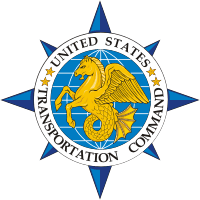

In October 2013, ACSF brought its campaign to reduce Uncle Sam’s costly oil spend to the Department of Defense (DoD) discussion regarding its upcoming Worldwide Express (WWX-6) delivery services contract. WWX-6 is likely to be the largest package delivery contract ever awarded by the federal government, worth over $500 million annually for 5 years.
In a memorandum to DoD, ACSF said that because federal agencies are now required by law to consider oil consumption and dangerous air emissions in awarding new transportation contracts, WWX-6 provides an exceptional opportunity for the government to lead by example.
In particular, ACSF said that both Executive Order 13514 and the Department’s own Strategic Sustainability Plan and Green Procurement Program oblige DoD to prefer vendors that can meet DoD’s transport needs while simultaneously advancing environmental and energy security goals. For example, to meet DoD’s multiple objectives, vendors can expand the use of alternative, cleaner transportation fuels, such as natural gas and electricity. That is likely to improve air quality, create more domestic jobs and curb the vast transfer of American wealth to oil-rich nations in the Middle East.
The Foundation’s DoD contract initiative builds on the group’s June 2013 letter urging the U.S. General Service Administration (GSA) to factor environmental and energy security objectives into the process for awarding the new $1.5 billion domestic delivery service contract for federal agencies, known as DDS-3.
On December 30, 2013, the Foundation submitted this memorandum (download PDF) to USTRANSCOM, the purchasing arm of the Defense Department (DOD), in response to the release of a December 13 Draft Performance Work Statement (PWS) for DoD’s Worldwide Express (WWX-6) delivery service contract.
U of Illinois Leads the Way Toward Cleaner Shipping
by Debra Levey Larson, NRES NEWS
The University of Illinois recently became the first academic institution to join the U.S. Environmental Protection Agency’s SmartWay Transport Partnership. U of I’s Housing Dining Services, through the efforts of a professor and four undergraduate students, estimated the emissions and petroleum used in deliveries to campus by its suppliers and committed to apply SmartWay tools and assistance to reduce the campus’ environmental impacts.
“As the first-ever academic institution to register in SmartWay, University of Illinois at Urbana-Champaign leads the way for universities and other institutions to work as shippers in SmartWay and engage with their carriers and suppliers to improve freight efficiency, reduce greenhouse gases and other emissions from goods movement while also helping enhance our nation’s energy security,” said Christopher Grundler, director of EPA’s Office of Transportation and Air Quality.
Launched in 2004, SmartWay has helped shippers and carriers save over 65 million barrels of oil (equivalent to taking more than five million cars taken off the road for a year) and cut air pollution by over 28 million metric tons of carbon dioxide and 22,000 tons of particulate matter.
Warren Lavey, an adjunct professor in U of I’s Department of Natural Resources and Environmental Sciences and the School of Earth, Society and the Environment, said that trucking services are major sources of greenhouse gases and other air toxins, consume large amounts of imported petroleum, and disproportionately impair the health of low-income and minority communities.
“Numerous cost-effective technologies, non-petroleum fuels, and other methods are available to reduce the harms from inefficient diesel trucks, but adoption rates are still slow,” Lavey said.
He noted that shippers respond to customer demands. Government agencies, universities, hospitals, and other large buyers of transportation services should lead by pressing their suppliers to haul freight fewer miles and use cleaner vehicles. “While sustainability goals and programs are widespread among major users of trucking services, procurements of trucking services seldom reflect preferences and incentives for vendors to reduce their harmful emissions and use of petroleum,” Lavey said.
Lavey is working with students to expand SmartWay participation at the U of I, other large customers in the community, University of Illinois at Chicago, and government agencies. He plans to use the SmartWay program as a case study in a new course on sustainability performance metrics and assessment techniques.
LNG Emerging As Fuel Of Choice For Vessels, Ferries
Leveling the road for natural gas vehicles can give drivers a break from summer gas price hikes
Morning Transportation: DELIVERY
LNG production, fueling terminals target marine industry
GSA Urged To Spur Alternative Fuel Vehicles In $1.5 Billion Contract for Deliveries
GSA To Spur Alternative Fuel Vehicles In $1.5 Billion Contract for Deliveries

 An upcoming five-year government-wide contract for package delivery services is a prime opportunity for the Obama Administration to make good on commitments to reduce America’s oil dependence and cut greenhouse gas emissions related to contract transportation services.
An upcoming five-year government-wide contract for package delivery services is a prime opportunity for the Obama Administration to make good on commitments to reduce America’s oil dependence and cut greenhouse gas emissions related to contract transportation services.
It’s time for the government to be a trendsetter for clean fuel trucking by starting at its own loading docks. GSA’s next government-wide contract for package delivery services known as DDS3 should have annual targets for increasing the use of alternative fuels and provide contract incentives for superior environmental performance.
What is DDS3? Read our FAQ.
Read the press release
GSA Releases Final RFQ for DDS3
ACSF’s Letter to Acting GSA Administrator Daniel M. Tangherlini
ACSF’s Memorandum to GSA
Vice Admiral Dennis V. McGinn, USN (Ret.), ACORE CEO and President, Letter of Support
Graham Richard, Advanced Energy Economy CEO, Letter of Support
Brian P. Wynn, Electric Drive Transportation Association President, Letter of Support
[sharethis]
Morning Energy: Upcoming Alternative Fuel Workshop for Feds and Companies
Natural gas vehicles will transform the nation’s transportation fuel habit
Guest Commentary: How to Jump-start the Energy Security Trust
How to Jump-Start the Energy Security Trust
Report Finds More Natural Gas Vehicles Would Not Raise Natural Gas Prices
Natural Gas for Marine Vessels: A Comparison
Driving on Natural Gas: Fuel Price and Demand Scenarios for Natural Gas Vehicles to 2025
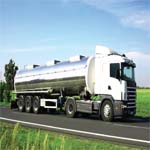
Driving on Natural Gas: Fuel Price and Demand Scenarios for Natural Gas Vehicles to 2025

Our new report finds that a transition to natural gas-fueled heavy duty and light duty vehicles over the next decade will have a minimal impact on natural gas prices. The report uses three scenarios to calculate potential natural gas demand and price impacts attributable to natural gas vehicles (NGVs).
Full Report
Download PDF • Request Print Copy
- Figure 5: Price Components of Retail CNG
- Figure 1: Natural Gas Demand, Transportation vs. Power Generation
- Figure 9: One Well=14,000 Honda Civics Driving with Natural Gas
The Future of Natural Gas: An Interdisciplinary MIT Study
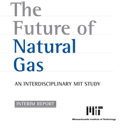
ACSF and several other groups initiated and sponsored the report. The other groups included the MIT Energy Initiative (MITEI) members Hess Corporation and Agencia Naçional de Hidrocarburos (Colombia), the Gas Technology Institute (GTI), Exelon, and an anonymous donor. Gregory C. Staple, the Foundation’s CEO, served on the report’s 18-person advisory committee. Incoming Energy Secretary Ernest J. Moniz, former MITEI director, testified before the U.S. Senate Committee on Energy and Natural Resources about this report.
Full Report
Download PDF • Request Print Copy
In the Press
Ernest Moniz, MIT Physicist, Nominated as Energy Secretary: The Washington Post, March 4, 2013
An M.I.T. Plan for Natural Gas with Planet in Mind: New York Times, June 9, 2011
MIT: Natural Gas to Become More Entwined in US Economy: SNL Financial, June 9, 2011
Natural Gas Gives Edge to US Manufacturers: Financial Times, June 8, 2011
The Future of Natural Gas: Geology.com, June 28, 2010
Does Our Energy Future Line in Natural Gas?: Consumer Affairs, June 28, 2010
The Future of Natural Gas: RedOrbit, June 28, 2010
Offshore Drilling Uncertainty Likely to Boost Search for Onshore Deposits: allvoices, June 28, 2010
Study Says Natural Gas Use Likely to Double: New York Times, June 25, 2010
MIT Study Urges US Gas Industry to Back Price on Carbon Emissions: Platts, June 25, 2010
For Climate Relief, US Will Turn to Gas: Nature.com, June 25, 2010
MIT Researchers See Natural Gas as the Choice for Lower Carbon Emissions: New York Times, June 25, 2010
MIT: The Future Is A (Natural) Gas: Forbes, June 25, 2010
Natural Gas Seen as Key in a Carbon-Constrained Futuree: Greentech Media, June 25, 2010
MIT Releases Major Report: The Future of Natural Gas: PhysOrg.com, June 25, 2010
MITEI-Led Study Offers Comprehensive Look at The Future of Natural Gas: MIT News, June 25, 2010
Natural Gas Use to Double in US in Coming Decades: MIT Report: Treehugger, June 25, 2010
Where Can I Fill Up? 2013 Assessment
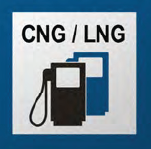
This updated edition of Where Can I Fill Up? expands on the information in the August 2012 report. It provides more than 20 pages of new information on who is building NGV fueling infrastructure, along with more detail on where and how this infrastructure is being added and government policies pertaining to the development of NGV fueling infrastructure.
Shale Revolution Moves Natural Gas Production Onshore Reducing Hurricane Price Shocks
The chart above shows that the rise in U.S. onshore natural gas production has tended to diminish the impact of hurricanes on prices. The percentage of onshore production is shown on the right axis and gas prices on the left axis. The most recent hurricane, Isaac, struck the Louisiana coast on August 28th as a Category 1 storm. Isaac knocked out electricity to more than 900,000 homes and is estimated to have caused about $2 billion in damage in Louisiana alone. However, unlike previous hurricanes, it had a negligible impact on natural gas prices nationwide. In the first half of 2012 before Isaac hit, U.S. marketed gas production averaged 6.2 percent from Federal Gulf of Mexico waters. Seven years before, the percentage averaged 19.2 percent.
Two years ago the American Clean Skies Foundation and the Bipartisan Policy Center jointly convened the Task Force on Ensuring Stable Natural Gas Markets to examine historic causes of instability in natural gas markets and to explore potential remedies. One of the Task Force’s findings was that the growth of on-shore shale gas was reducing the susceptibility of gas markets to price instability (while also accommodating new demand). The relatively minimal impact of recent Gulf hurricanes on gas prices provides support for this thesis. To learn more, read the report of the 2010 Task Force on Ensuring Stable Natural Gas Markets.
Sources
Natural gas price and production data: Energy Information Administration, November 30, 2012, http://www.eia.gov/naturalgas/data.cfm
Also see:
- Hurricane Damage to Natural Gas Infrastructure and Its Effect on the U.S. Natural Gas Market. Energy and Environmental Analysis, Inc. November 2005.
- Comparing the Impacts of the 2005 and 2008 Hurricanes on U.S. Energy Infrastructure. U.S. Department of Energy. February 2009.
- Short-Term Energy Outlook Supplement: 2012 Outlook for Hurricane-Related Production Outages in the Gulf of Mexico. U.S. Energy Information Administration. June 2012.
- BSEE Hurricane Isaac Activity Statistics: August 29, 2012. Bureau of Safety and Environmental Enforcement.
What Can 1mcf of Natural Gas Do?
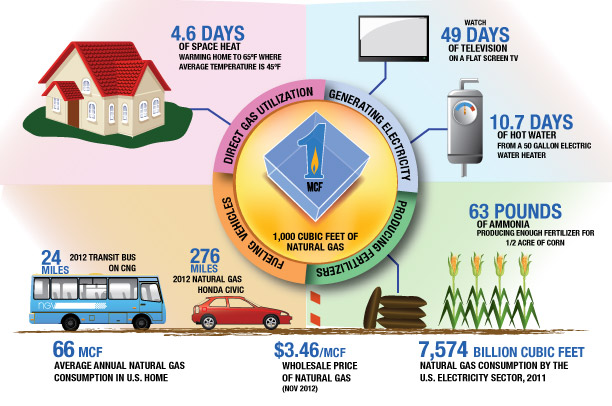
Sources
- Electricity consumption of common appliances: Estimating Appliance and Home Electronic Energy Use, US Department of Energy, August 31, 2012.
- Energy consumption for water heaters [standard 50-gallon models]: ENERGY STAR Residential Water Heaters: Final Criteria Analysis, US Environmental Protection Agency, April 1, 2008.
- Fuel economy for NGV Honda Civic: 2012 Honda Civic Natural Gas Overview, American Honda Motor Co., Inc., 2012.
- Fuel economy for CNG transit buses: Business Case for Compressed Natural Gas in Municipal Fleets, National Renewable Energy Laboratory, June 2010.
- Natural gas consumed in production of nitrogen fertilizer [anhydrous ammonia]: Natural Gas and the U.S. Fertilizer Industry, Harry Vroomen, The Fertilizer Institute, July 15, 2010.
- Nitrogen fertilizer and corn: Fertilizer Use and Price, Table 10-Nitrogen used on corn, rate per fertilized acre receiving nitrogen, selected States, 1964-2010, US Department of Agriculture, Economic Research Service, May 27, 2011.
- Average household fuel use for space heating: 2005 Residential Energy Consumption Survey–Detailed Tables, US Energy Information Administration, January 2009.
- Average heating degree days data: Table 1.9 Heating Degree-Days by Census Division, Selected Years, 1949-2011, Annual Energy Review 2011, US Energy Information Administration, September 2012.
- For more info about heating degree days, see: Degree Days, Energy Explained, US Energy Information Administration, October 21, 2011.
- Average household natural gas consumption: Consumption in Physical Units, Totals and Averages, U.S. Homes (CE2.6), 2009 Residential Energy Consumption Survey, US Energy Information Administration, October 16, 2012.
- Wholesale natural gas price data: Henry Hub Gulf Coast Natural Gas Spot Price, US Energy Information Administration.
- Other Assumptions: 7.2 MMBtu/MWh average heat rate for electricity generated from natural gas fired combined cycle power plants.
Where Can I Fill Up?
This new 60 page ACSF report provides a comprehensive up-to-date survey of private sector and state government initiatives to build out natural gas vehicle (NGV) fueling stations across America. It covers investments in new CNG and LNG facilities and contains detailed state-by-state profiles of incentives (tax credits, loans, grants, public utility programs) now available to promote NGV infrastructure.
A New Energy Option: North America’s New Natural Gas Resources And Their Potential Impact On Energy and Climate Security
By Gregory C. Staple Esq. and Joel L. Swerdlow, Ph.D., 2009.
Working Paper
Politico 2012: Shale Gas Rocks The Economy…And Politics
During the recent Republican and Democratic presidential nominating conventions, ACSF distributed more than 60,000 copies of a special eight-page newspaper supplement about America’s shale gas story and the Foundation’s policy work. This unique advertising supplement was prepared by ACSF in conjunction with the Washington D.C.-based Politico newspaper and was inserted in the local Tampa Bay Times and Charlotte Observer newspapers provided to all convention participants. More than 30,000 copies of the supplement were also distributed in Washington D.C. as part of a post-convention issue of Politico.
Tech Effect: How Innovation in Oil and Gas Exploration is Spurring the U.S. Economy
By E. Harry Vidas, Vice President, ICF International.
This new ACSF report shows that shale gas and tight oil production will add $167 billion to $245 billion to the U.S. gross domestic product by 2017, and that will deliver 835,000 to 1.6 million new jobs. This is only one of the many ways technological innovations in natural gas and tight oil production are transforming the U.S. economy.
Download Full Report (PDF) | Read Executive Summary | Request Print Copy
Full Report
- Exhibit 1-1 U.S. Map of GDP and Employment Impacts
- Exhibit 1-4 Domestic Job Impacts of Alternative Uses of Natural Gas
- Exhibit 2-2: Map of Lower US Shale Plays
- Exhibit 5-8 U.S. Map of GDP Change in 2017
- Exhibit 5-9 U.S. Map of Employment Change in 2017
- Exhibit 6-1: Summary of Change in Impacts
- Exhibit 4-3 Shale Gas and U.S. Economic Development
- Exhibit 5-6 Changes in GDP and Employment Impacts
Oil Shift: The Case for Switching Federal Transportation Spending to Alternative Fuel Vehicles

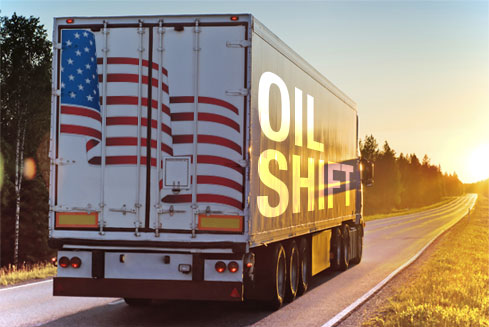
-
Get Involved
- Learn About the Contracts
- Read the Oil Shift Report (PDF)
- FAQ
- Events
- Contact Us

The GSA Agrees
The GSA recently decided to adopt provisions of our plan by including clean fuel and environmental metrics in its upcoming $1.5 billion government-wide overnight delivery contract. Read our press release, and our original letter to GSA’s Administrator.
We are helping federal agencies purchase greener, more fuel efficient, lower cost shipping and delivery services.That will put more clean trucks on the road in 2015.
How It All Began
In 2012, we launched a new campaign to cut back the level of harmful pollution associated with hauling freight and packages to and from the federal government — a $150 billion a year business.
Our landmark 2012 Oil Shift report by Gregory C. Staple and Warren G. Lavey made the case for switching federal transportation spending to alternative fuel vehicles. The report showed how the government could do that better by shifting more and more of its trucking and overnight delivery contracts to vendors that have more efficient fleets and use greater volumes of alternative non-petroleum fuels, such as natural gas and electric vehicles.
Our Oil Shift campaign has generated support from a broad range of organizations including the Electric Drive Transportation Association (EDTA), the American Council on Renewable Energy (ACORE), and the Advanced Energy Economy (AEE). We also garnered endorsements from leading environment and public health advocates.
Washington has begun to listen. First, GSA decided to adopt provisions of our plan by including clean fuel and environmental metrics in a $1.5 billion government-wide overnight delivery contract. Then, on March 19, 2015, President Obama issued a new Executive Order on federal sustainability that, among other things, includes requirements for considering environmental impacts in the future procurement decisions of the seven largest procuring agencies.
The Road Ahead
We have asked the Department of Defense to make cleaner domestic fuels a priority for its transport vendors. With your help, we can improve air quality, create more American jobs, and promote energy independence.
Oil Shift: The Case for Switching Federal Transportation Spending to Alternative Fuel Vehicles

Energy 101: Natural Gas Transportation

As America produces more and more natural gas, lots of people are thinking about using clean-burning natural gas to run our cars and trucks. It’s not only likely to cost less but it could cut back our oil imports a whole lot, especially from unfriendly regimes.
Natural Gas for Marine Vessels: U.S. Market Opportunities
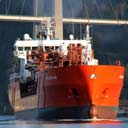
As diesel fuel costs become higher and more volatile, the transportation sector is buzzing about the potential for natural gas to move our goods and services. Most of the talk has focused on fleet vehicles and heavy-duty trucks. This winter ACSF commissioned a review of the maritime market opportunities for natural gas. The study offers the first in-depth look at the challenges and prospects for converting U.S. marine vessels to liquefied natural gas (LNG).
A PDF of the report is available for download here (36 pages).
All About Shale Gas
Shale Gas and America’s Future is a 30-minute, made-for-TV film that looks at how local communities in Pennsylvania are dealing with the potential benefits and risks of shale gas development. In November 2012 the film was awarded the top prize for short documentaries by the Washington D.C.-area association of the Television, Internet & Video Association (TIVA). The film was produced for ACSF in 2010 by the award-winning, Washington D.C.-based documentary group Hillmann & Carr. Click on the image below to view the film.
The second image takes you to ShaleCountry.com. This web site features first-person accounts of the impact of gas production on the economy, the environment and the lives of people living in major shale “plays”– the Haynesville in Louisiana, the Fayetteville in Arkansas, and the Marcellus in New York and Pennsylvania.
[SlideDeck id=’809′ width=’682px’ height=’280px’]
Today experts tell us that America has roughly a 100-year supply of natural gas, a fuel that burns with 50% less global warming pollution than coal, and 20% less than most petroleum fuels. And, on a barrels-to-barrels comparison, in 2010, domestic U.S. production of natural gas was greater than that of coal and almost double that for oil.
300 Million Gallons of Diesel Every Year

That’s how much mass transit buses consume.
That’s nearly $1 billion in economic stimulus, gone.
Natural Gas Vehicles

FOR MORE INFORMATION
NATURAL GAS VEHICLES (NGVs): An Economical and Clean Alternative
Natural gas can also be compressed and used to fuel the internal combustion engines used in cars, trucks and buses.
- Reduce carbon monoxide emissions 90%-97%
- Reduce nitrogen oxide emissions 35%-60%
- Potentially reduce non-methane hydrocarbon emissions 50%-75%
- Emit fewer toxic and carcinogenic pollutants
- Emit little or no particulate matter
Natural Gas Supply
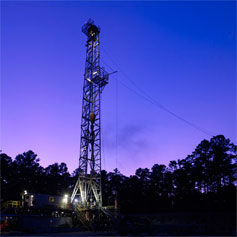
FOR MORE INFORMATION
The scope of North America’s future natural gas supplies is summarized in a 2009 briefing paper
that was commissioned by the Foundation. The report, by Navigant Consulting, draws on that group’s landmark 2008 survey of shale gas production.
A Look Back: Early History
The discovery of natural gas dates back to the ancient Chinese, who dug down thousands of feet and installed bamboo pipes. Many years later, in the seventh century CE, natural gas transported through secret pipes fueled “eternal fires” in temples near the Caspian Sea.
Natural Gas Basics

FOR MORE INFORMATION
What is natural gas? Natural gas is a naturally occurring fossil fuel that can be found in various underground rock formations worldwide, formed millions of years ago from the decaying remains of plants and animals. When it is extracted, natural gas is odorless, colorless and tasteless, and is composed mainly of methane.
Methane is clean burning and chemically simple. It has four hydrogen atoms and only one carbon atom, unlike most carbon-rich fuels such as coal, wood and oil. Natural gas is also the only fossil fuel that does not leave a residue when burned and, given its chemical composition, releases far less carbon dioxide compared to other fossil fuels.
(more…)
MIT Future of Gas Study
In 2008, the Foundation agreed to underwrite a comprehensive new two-year study by the Massachusetts Institute of Technology (MIT) faculty on the role of natural gas in the United States energy future. The study is designed to provide a detailed assessment of the supply of natural gas both in the U.S. and overseas over the mid to longer term, and to examine the potential sources of demand for natural gas during this time frame.
This study, which will be completed in the Summer of 2010, will augment MIT’s prior reports on The Future of Coal (2007) and The Future of Nuclear Power (2003).
The study is being directed by Dr. Ernest Moniz, Director of the MIT Energy Initiative, and Melanie Kenderdine, Associate Director.
The work of the MIT study team is also overseen by an independent Advisory Board whose members include:
|
|
Managing NatGas Price Volatility
p>ACSF and the National Commission on Energy Policy (NCEP) are co-sponsoring a 16-month Task Force to develop new government and private sector options for managing natgas price volatility.
America’s growing natural gas resource base is now widely recognized. Yet, the development of these resources, especially unconventional shale gas “plays”, will depend on sustained long term demand from end-users at prices that are sufficient to cover upstream production and transport costs. Whether or not this demand will be forthcoming – and at a sufficient price level – is now the subject of considerable debate.
Copenhagen Forum
The Foundation, together with the Worldwatch Institute and the UN Foundation, brought natural gas to the center of climate policy discussions in Copenhagen during the landmark UN negotiations for a new global climate change treaty in December 2009. These negotiations are formally known as the 15th Conference of the Parties (COP-15) to the UN Convention on Climate Change (UNFCC). The initiative will highlight the potential of natural gas to contribute to near- and medium-term emission reductions.

